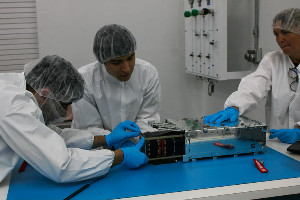| Satellite | SOC-i (Satellite for Optimal Control and Imaging) |
|---|---|
| Type | CubeSat |
| Units or mass | 2U |
| Status | No signal? (Assuming no contacts based on social media updates and lack of SatNOGS reports as of 2024-12-22) |
| Launched | 2024-07-04 |
| NORAD ID | 60203 ? |
| Deployer | RailPOD [Tyvak] |
| Launcher | Firefly Alpha (ELaNa 43) |
| Organisation | University of Washington |
| Institution | University |
| Entity type | Academic / Education |
| Nation | US |
| Launch brokerer | NASA CSLI / ELaNa |
| Oneliner |
Advanced guidance, navigation and control (GNC) payload and Earth imaging camera. |
| Description |
Technology demonstration that will demonstrate an experimental attitude control scheme on orbit. Advanced guidance, navigation and control (GNC) payload capable of reorienting the spacecraft while satisfying multiple pointing constraints. Along side a standard GNC system, this will provide accurate pointing for an onboard Earth imaging camera. The Aeronautics & Astronautics CubeSat Team (AACT) is an organization of faculty, graduate, and undergraduate students working together to design, build and test CubeSats. Our 2U CubeSat mission is to teach students the fundamentals of space systems and provide a hands-on experience that complements academic work. SOC-i is AACT’s first mission. A technology demonstration, SOC-i will carry an advanced guidance, navigation and control (GNC) payload capable of reorienting the spacecraft while satisfying multiple pointing constraints. Alongside a standard GNC system, this payload will provide accurate pointing for an onboard Earth imaging camera. SOC-i will educate students on space and satellite design, development, and testing through building a CubeSat that will fly the first in-space demonstration of a GNC payload completing real-time optimization based constrained attitude control. SOC-i also has a camera to demonstrate SOC-i’s pointing abilities and return pictures from orbit to foster excitement about space at UW. The development and construction of SOC-i is primarily handled by the 40+ UW students involved in the project. The project has introduced these students to the art of amateur radio communications and during the flight mission will be used as an educational tool to explain amateur radio principles and theory. The novel attitude control technology on SOC-i can enable enhanced amateur radio satellite operations on future missions and thus contribute to the advancement of the amateur satellite service. It uses onboard computing to execute slew maneuvers with very simple instructions, enabling accurate and persistent pointing at a ground location or exclusion of Earth locations where that may be appropriate. |
| Notes | |
| Sources | [1] [2] [3] [4] |
| Photo sources | [1] [2] [3] |
| COTS subsystems |
|
| Subsystems sources | [1] |
| COTS compoments |
|
| Components sources | [1] |
| On the same launch |
Last modified: 2024-12-22




